Strategic Sales Plan Examples: 13 Sales Plan Templates
Casey O'Connor
A strategic sales plan is a must-have for any business looking to increase their sales, amp up their revenue, bring a new product to market, or branch into a new territory.
In this article, we’ll go over everything you need to know about strategic sales plans: what they are, when to create one, and exactly what they need to include. We’ll also show you a handful of real-life, tangible sales plan template examples and tips for implementation.
Here’s what we’ll cover:
- What Is a Strategic Sales Plan?
- When You Should Implement a Strategic Sales Plan
- What to Include In Your Sales Plan
- 13 Sales Plan Template Examples
What Is a Strategic Sales Plan?
A strategic sales plan is designed to guide a sales organization through their overarching sales strategy. It provides them with access to the resources needed to prospect, pitch to, and close new accounts.
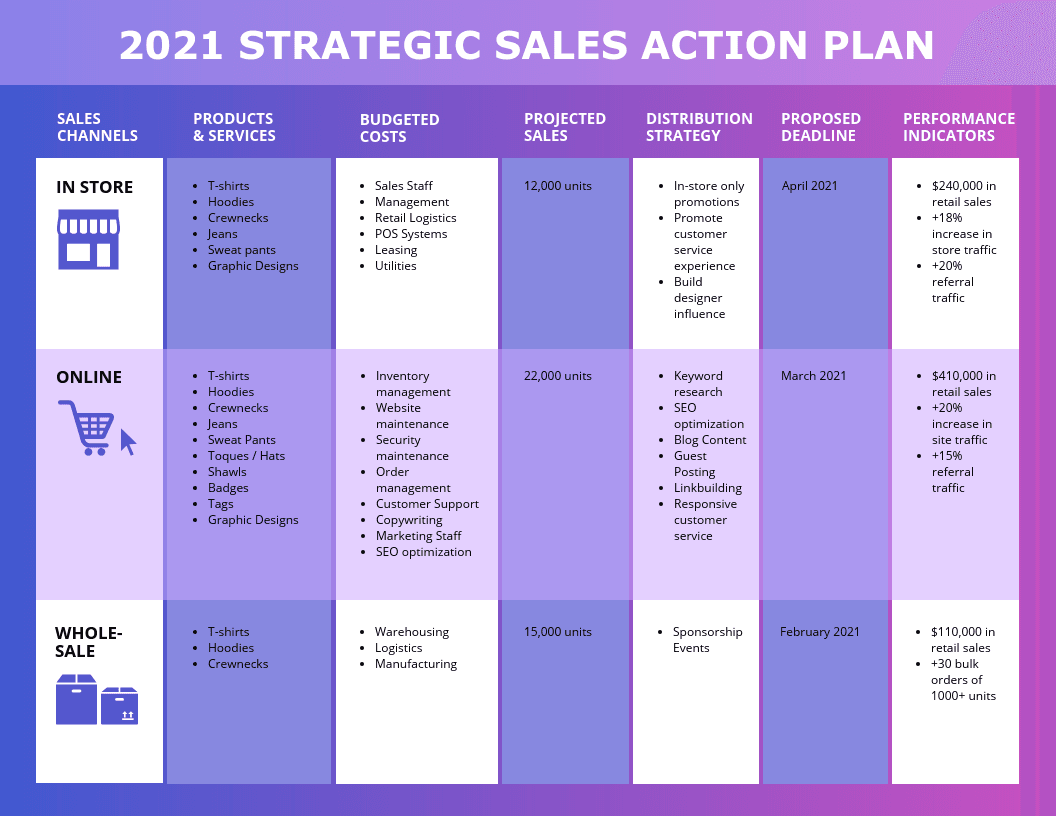
Strategic sales plans can include any combination of the following:
- Ideas: If you utilize a certain sales methodology — consultative selling or target account selling, for example — you might outline its key principles and a few tactical examples of it in action in your strategic sales plan. Your strategic sales plan should also include an overview of your target customer.
- Processes: In order for your sales team to reach maximum productivity, it’s important that your sales processes are clearly defined and standardized. Your sales team — both new hires and seasoned vets alike — should be able to refer to your sales plan for a repeatable, scalable process that’s backed by solid metrics. The processes should provide direction to sales reps that allow them to contribute to the company’s goals.
- Tools & Tactics: The best strategic sales plans are more than just high-level strategy and goals. They also include specific, step-by-step strategies that sales reps can implement in sales conversations, as well as the specific tools and content that reps need to close more deals.
Sales plans also typically spell out the organization’s revenue and overall business goals, as well as the KPIs and benchmarks that sales managers and other stakeholders will monitor to determine whether or not those goals are being met.
They should also outline management’s strategic territory design and quota expectations, with specific indicators and data to back those decisions.
Finally, these sales plans should take into account your current team’s sales capacity and specifically address the acquisition plan for any resources that are not yet available but may be necessary for future growth.
When You Should Implement a Strategic Sales Plan
If your sales team doesn’t already have a strategic sales plan in place — that is, one that’s referenced and updated regularly and the product of careful data analysis and inter-team collaboration — you may want to consider creating one.
Research shows that the majority of the highest-performing sales teams operate under a formalized, closely monitored sales structure.
On the other hand, most underperforming sales teams lack this structure.
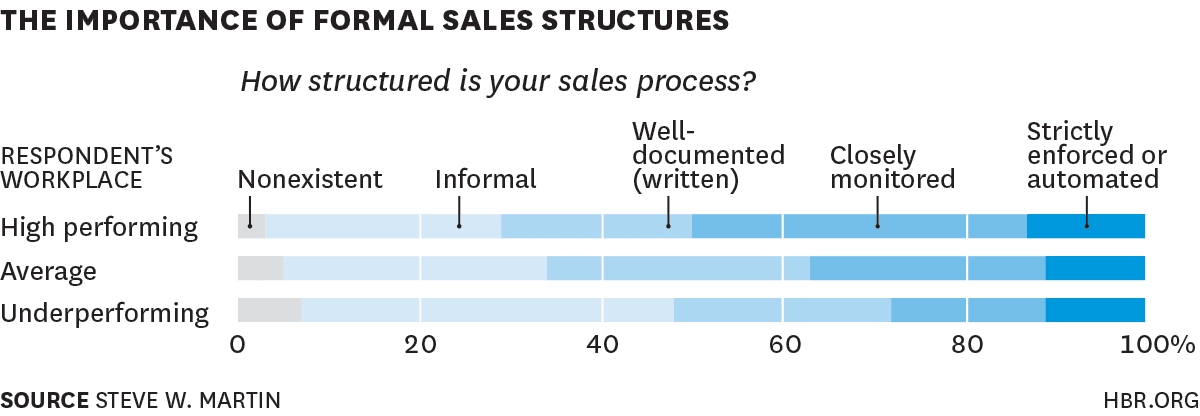
It’s clear that a well-defined sales plan is one of the prerequisites to optimized sales productivity and success; every salesforce should strive to create and adopt one if they want to meet their sales goals more efficiently.
That being said, there are a few key indicators that signal a need for more urgency in putting a strategic sales plan in place.
You’re Trying to Increase Sales
If you’re looking to increase the number of sales your team closes, you’ll need to widen the topmost part of your funnel: prospecting. 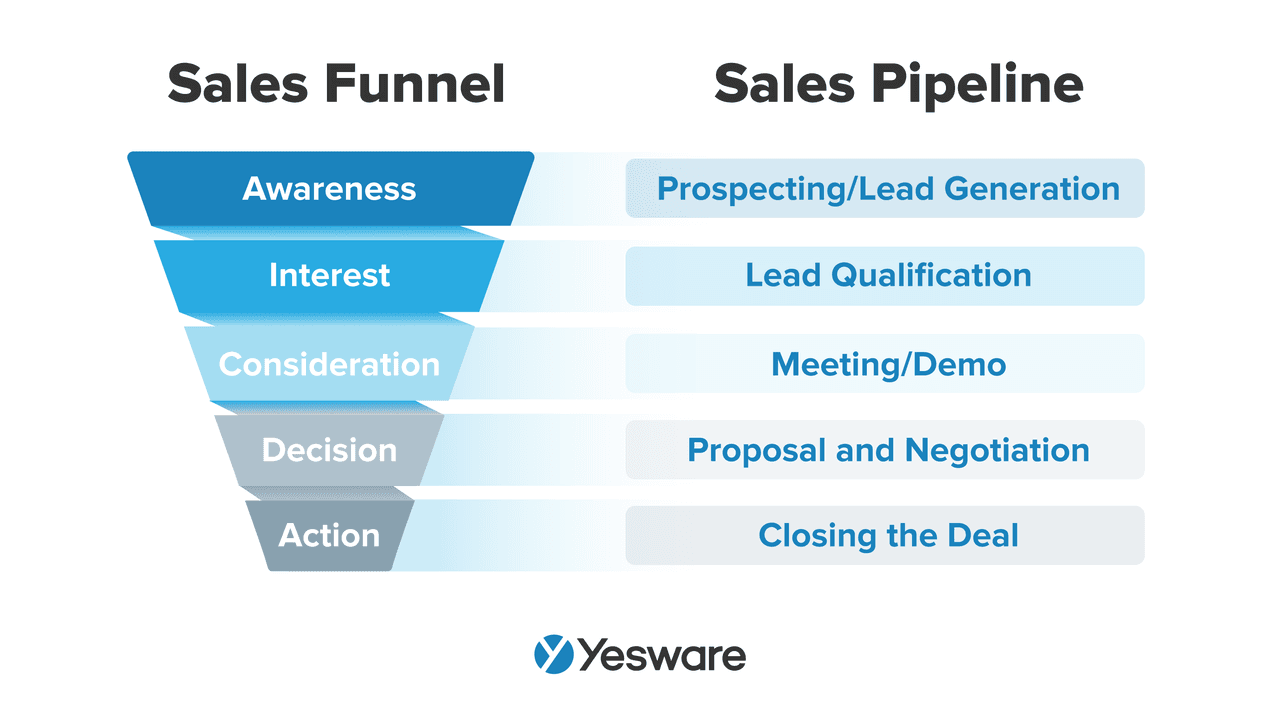 The more well-qualified new leads your business attracts, the higher your conversion rate will be.
The more well-qualified new leads your business attracts, the higher your conversion rate will be.
A strategic sales plan will help your sales and marketing teams align their processes so that your outreach efforts are tailored to your target audience.
You’re Looking to Amp Up Your Revenue
For startups and small businesses, attaining as many new customers as possible is usually the name of the game.
For larger or more established businesses, however, the business plan may instead emphasize revenue goals. In other words, the deal size starts to matter much more than deal volume.
A sales strategy plan can help salespeople target and nurture higher-value accounts. Sales planning can also boost your revenue by illuminating untapped potentials for revenue growth within your existing customer base through cross-selling, upselling, and referrals.
You’re Gearing Up to Launch a New Product
A sales strategy plan is crucial for businesses that are preparing to bring a new product to market.
Thoughtful sales planning will ensure your go-to-market strategy is optimized and designed for short-term and long-term success by clearly defining and speaking to the pain points of your ideal customer profile. 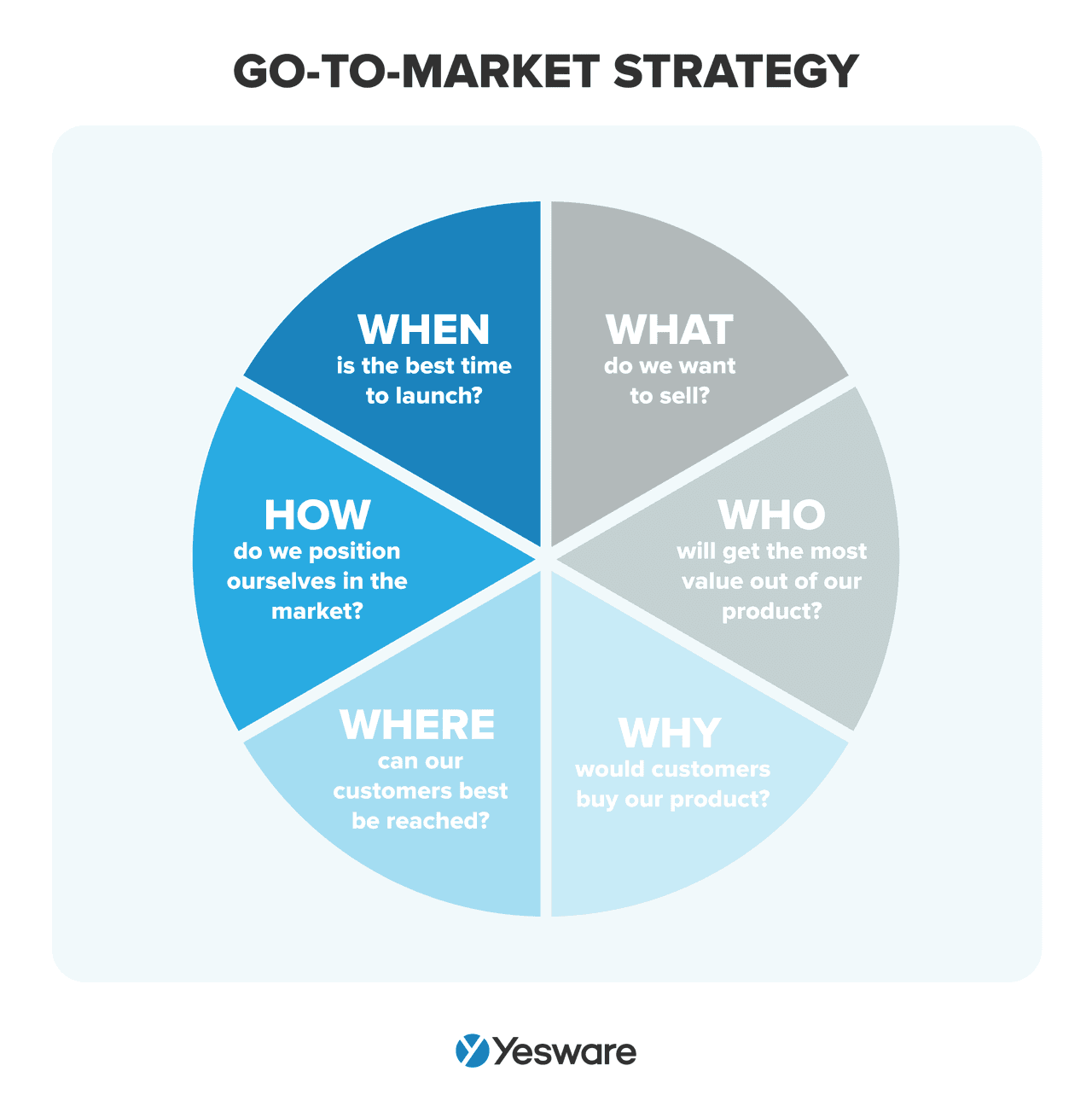 Remember that the process of creating a sales plan shouldn’t be rushed but instead should be driven by data and careful consideration. We’ll go over exactly what to include in the next section of this article.
Remember that the process of creating a sales plan shouldn’t be rushed but instead should be driven by data and careful consideration. We’ll go over exactly what to include in the next section of this article.
One last note: for businesses that already use strategic business planning (or for those on their way after reading this article), be sure to update your plan at least yearly. Many businesses at least review their plan, if not update it more formally, on a quarterly basis.
What to Include In Your Sales Plan
Ultimately, your strategic sales plan will be unique to your company and its specific goals.
Your team members in sales, marketing, and customer success should collaborate and align their resources and insight to design a streamlined, cohesive sales cycle that aligns with the buyer’s journey.  That being said, most sales plans include a relatively standard set of components. To do this justice, it’s important to understand the current operating status of your team’s people, processes, and technology.
That being said, most sales plans include a relatively standard set of components. To do this justice, it’s important to understand the current operating status of your team’s people, processes, and technology.
Consider including the following components in your strategic business plan.
Mission Statement
A mission statement concisely explains a company’s purpose for being by speaking to its purpose, values, and goals. 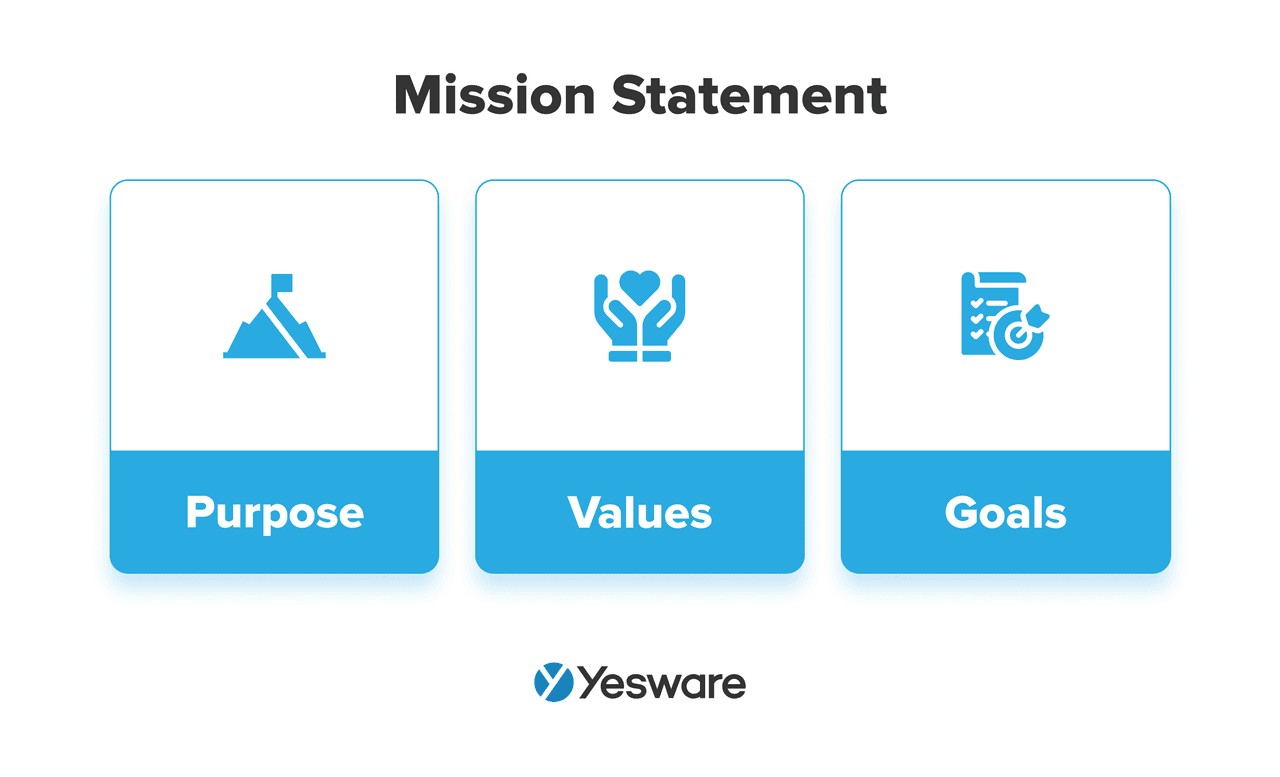 Consider a company’s mission statement like its North Star; it can act as a guiding force for decision-making that’s consistently aligned with the ethics and values of the company.
Consider a company’s mission statement like its North Star; it can act as a guiding force for decision-making that’s consistently aligned with the ethics and values of the company.
Industry & Market Conditions
Great sales planning cannot be performed in isolation. Your plan must take into account the current market conditions, including any challenges, recent disruptions, or upcoming notable events.
Organization Chart
A sales organization chart is like a cheat sheet for your sales team.
A sales org chart can range in scope from very simple, like the one above, to more complicated. Some go as far as naming individual employees and outlining their specific responsibilities.
A detailed org chart is especially helpful for efficiently onboarding new hires.
Product Info & Pricing
No sales plan would be complete without a one-sheet that outlines the features, benefits, and value proposition of your product or service.
It’s also helpful to include information about pricing tiers, as well as any discounts or promotions available for leverage at a sales rep’s discretion.
Compensation Plan
While we have no doubt that you’ve hired only the most intrinsically motivated salespeople, remember the bottom line: cash is king.
Money is the primary motivator for most salespeople, regardless of how truly loyal and hard-working they may be.
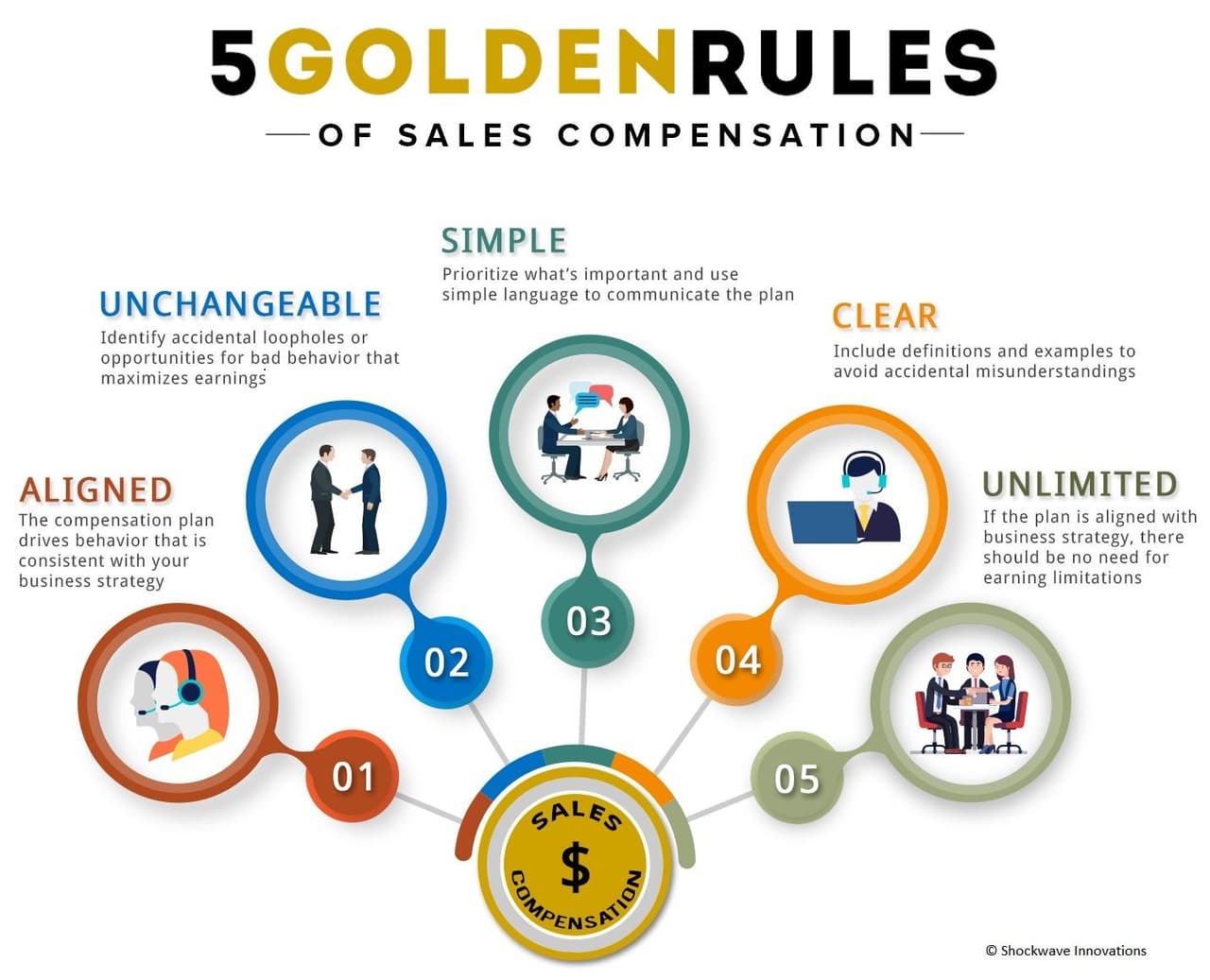
With that in mind, it’s a good idea to include your company’s compensation plan and commission structure in your sales plan. This is a surefire way to motivate your team to continuously improve their sales performance.
Target Market & Customer
One of the most important components of your strategic sales plan is your ideal customer profile and buyer persona. 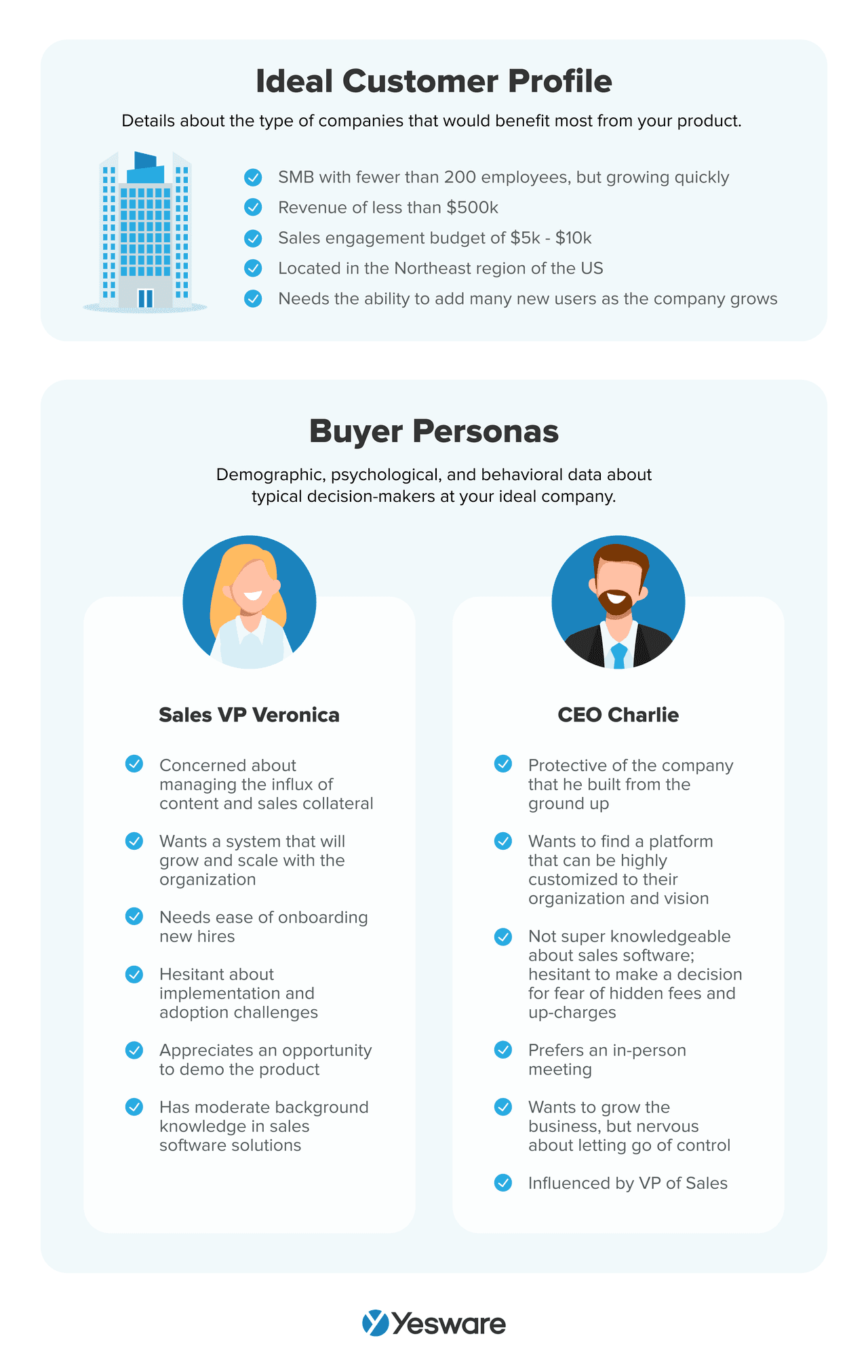 It’s imperative that sales reps have a deep understanding of your ideal customer so that they can speak directly to the needs and pain points of your target market.
It’s imperative that sales reps have a deep understanding of your ideal customer so that they can speak directly to the needs and pain points of your target market.
Sales Enablement
With the tremendous rise in content marketing, it can be challenging for salespeople to keep track of the various materials available for generating new business.
Your strategic sales plan should direct your sales team to the many resources available to them to leverage throughout the sales cycle. It should also highlight the tools, software, CRM, and training — collectively known as sales enablement tools — available to and expected of them. 
Branding & Positioning
The strategic sales plan should offer at least a high-level overview of your brand and messaging specifics, including social media presence. Take the time to optimize your company’s LinkedIn presence — it’s a goldmine of new business opportunities.
Marketing Strategy
In today’s day and age, it’s unlikely that your sales and marketing team are working in isolation from one another. At a certain point, sales and marketing strategies start to flow together until they (ideally) perform in harmony.
Still, it’s important to outline the perspective of the marketing team within your strategic sales plan. This will help your salespeople fine-tune their sales pitch and speak more meaningfully to the needs of the customer.
Prospecting Strategy
Most salespeople report that their number one challenge in lead generation is attracting qualified leads.
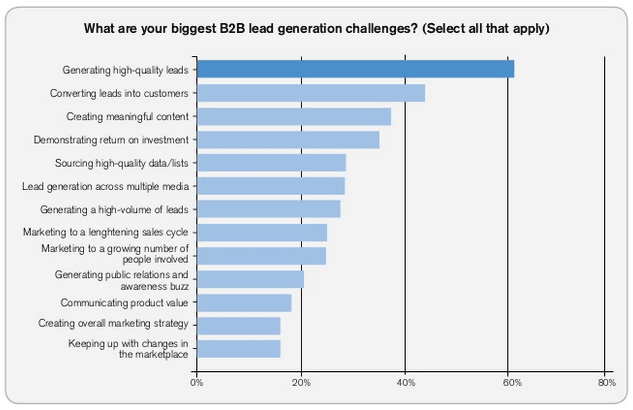
Prospecting can certainly be daunting, but it’s worth the effort to get it right. Tweak and fine-tune the process until you’re sure it’s as efficient as possible. Make sure it’s repeatable and scalable, and map it out within your sales plan.
Action Plan
Any good strategic sales plan will also include a step-by-step section, much like a playbook. Here, you’ll outline the specific tactics and processes — including scripts, demos, and email templates — that have been proven to move prospects through the sales funnel.
Be as specific as possible here. This will act as a blueprint for the day-to-day sales activities for your team.
Goals
It’s important that your salespeople know what they’re working toward. Use the SMART goal framework to outline your company’s goals, and include them in the sales plan. 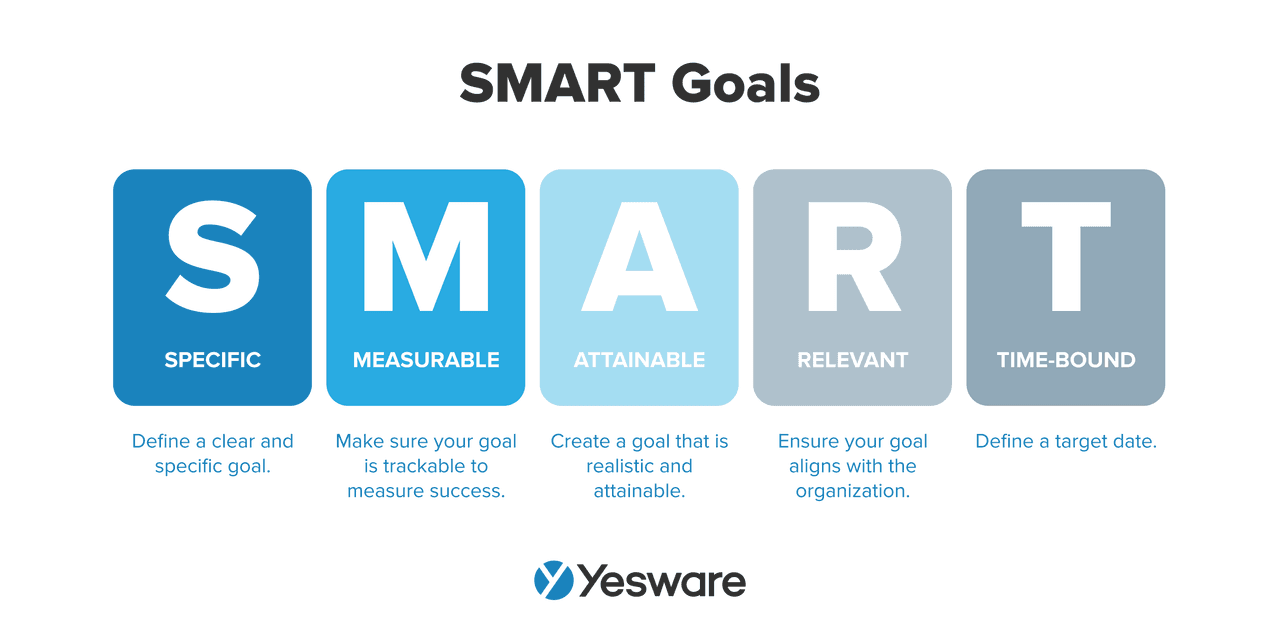 These will help guide both your day-to-day and bigger-picture sales actions.
These will help guide both your day-to-day and bigger-picture sales actions.
Budget
It can be tempting to leave the numbers with the finance department, but financial transparency can go a long way in creating a culture of trust among your sales team.
You don’t need to go through every line item in the spreadsheet, but it’s not a bad idea to include a high-level look at where the dollars are flowing.
KPIs, Metrics, and Benchmarks
Be sure to give your team a snapshot of how they’re currently performing, with real numbers to back it up.
By doing so, you help them self-initiate regular SWOT analysis of their own sales actions and processes. This will give them an opportunity to right the course if things aren’t going according to plan.
Tip: Looking to fuel your sales plan with data-backed findings? Grab our free ebook below.
 Sales Engagement Data Trends from 3+ Million Sales ActivitiesLooking at millions of tracked email activity over the past few years, this ebook is filled with our top studies and findings to help sales teams accelerate results.
Sales Engagement Data Trends from 3+ Million Sales ActivitiesLooking at millions of tracked email activity over the past few years, this ebook is filled with our top studies and findings to help sales teams accelerate results.13 Sales Plan Template Examples
Remember that your company’s strategic sales plan will be highly unique. It may take some time and tweaking to find the components and format that best meet the needs of your business.
Here are 13 sales plan templates to help you get started.
1. Product Launch Plan Template
Sales and marketing teams create a product launch plan when they’re preparing to launch a new product.
When these two teams collaborate to create a successful product launch plan, they can help generate reliable revenue quickly.  The product launch plan helps sales and marketing organize their messaging, competitive and market analysis, sales strategies, and target market specifics in one streamlined place that all stakeholders can access.
The product launch plan helps sales and marketing organize their messaging, competitive and market analysis, sales strategies, and target market specifics in one streamlined place that all stakeholders can access.
A product launch plan should include your product’s positioning statement, a SWOT competitive analysis, detailed market analysis, sales strategies and tactics, and details about the target market.
2. Ideal Customer Profile Template
One way to avoid wasting time on unproductive leads is to include an ideal customer profile (ICP) in your sales plan. Here’s a sample:

This will help ensure your prospecting campaigns are targeted and attract only the most qualified leads from the get-go.
3. Microsoft Word Sales Plan Template
Here’s a great example of a sales plan goals template, easily accessible through Microsoft Word.
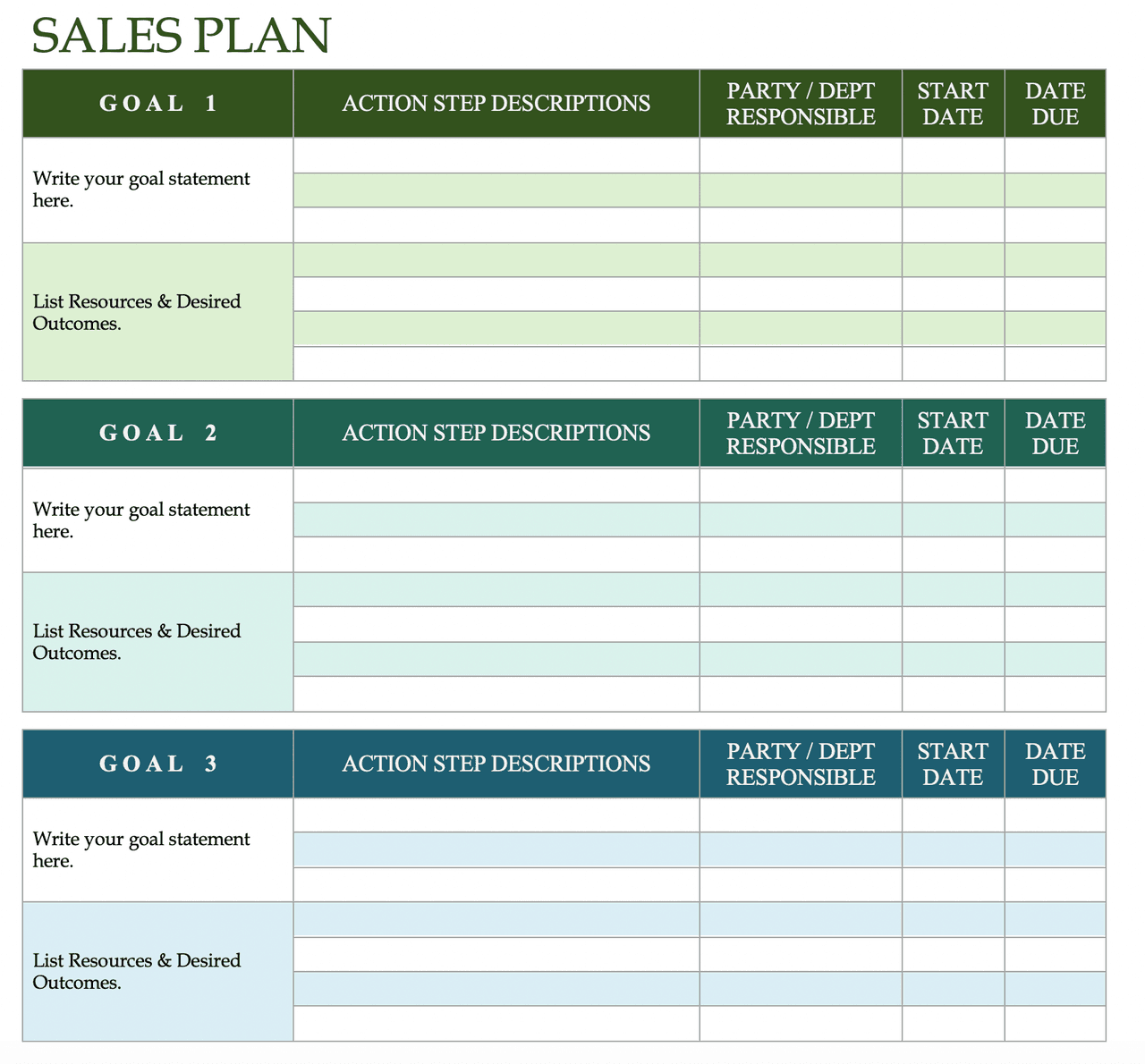 Goals, deadlines, and the parties responsible for meeting them are clearly laid out within this document.
Goals, deadlines, and the parties responsible for meeting them are clearly laid out within this document.
4. 30-60-90 Day Sales Plan Template
The concept behind a 30-60-90 day sales plan is simple: it outlines the strategy, goals, and action steps goals for the first 30/60/90 days of a new sales territory or a new sales position. 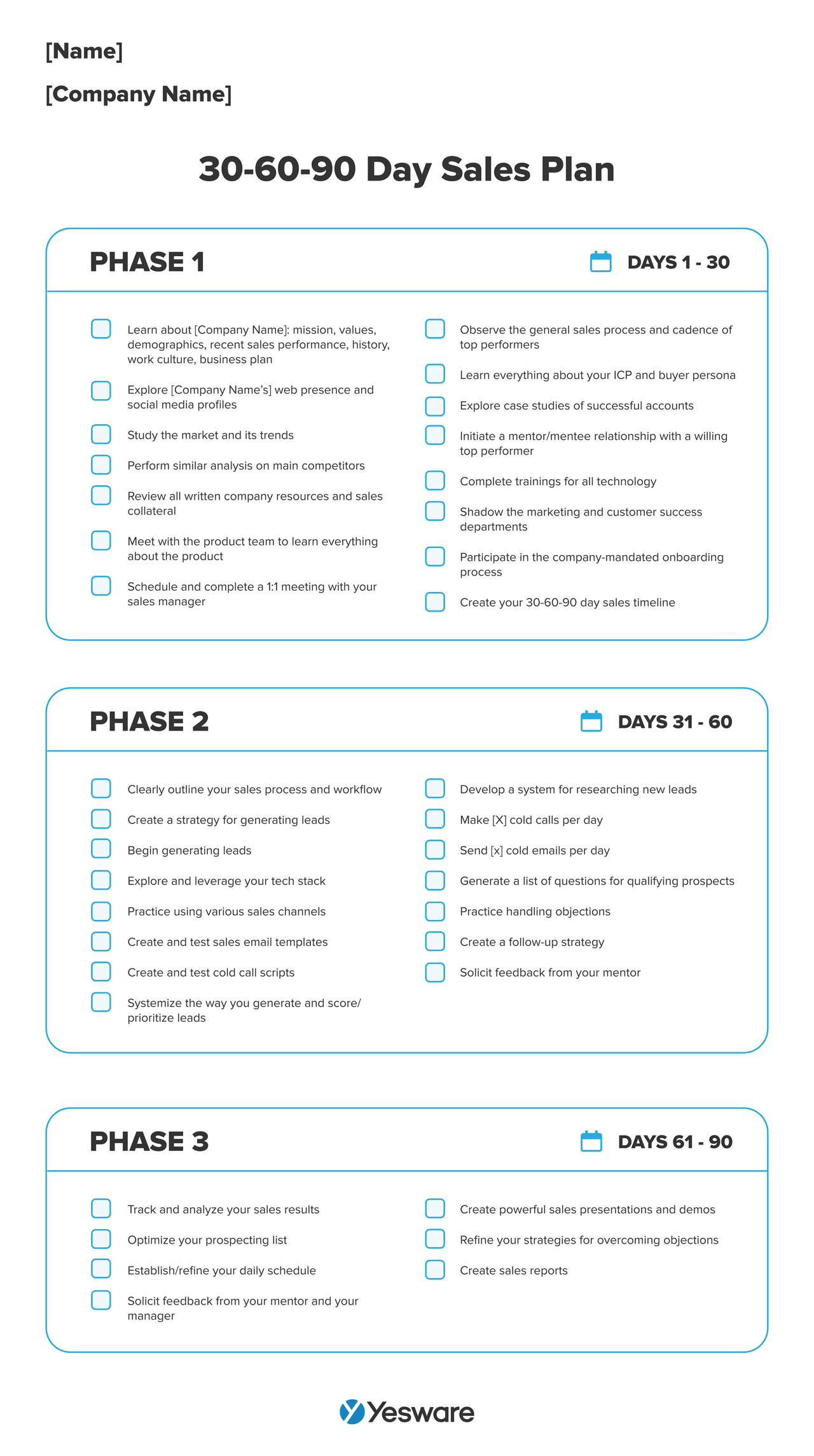 This kind of document is especially helpful for companies in periods of growth or expansion. And can save a tremendous amount of time and effort in the onboarding process.
This kind of document is especially helpful for companies in periods of growth or expansion. And can save a tremendous amount of time and effort in the onboarding process.
5. Buyer’s Guide Template
A buyer’s guide is a short, simple information sheet that describes your product or service, its features and benefits, and its use. Below is an example of a buyer’s guide from Wayfair.

In many cases, this document is as useful internally as it is for the customer.
6. Marketing Alignment Sales Plan Template
If your company hasn’t already formally aligned sales and marketing, start with this type of sales plan template (basic example below), as most traditional sales plans already assume that these two teams collaborate regularly.
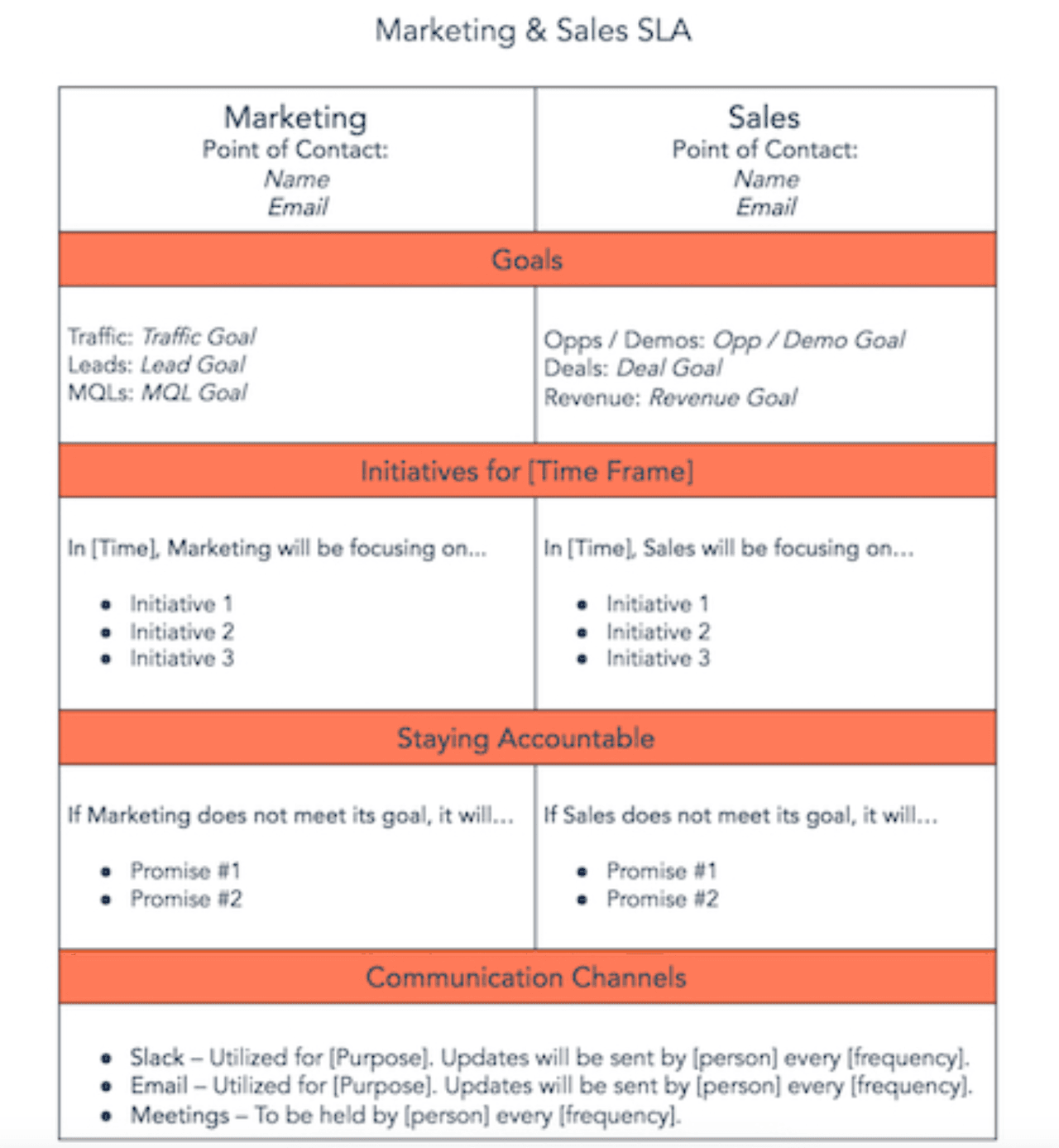
One key component of a marketing alignment sales plan template is the presence of an ideal customer profile and buyer personas.
The marketing alignment sales plan template should also focus on cohesive, on-brand messaging between marketing campaigns and sales conversations.
This type of sales plan template helps keep everyone on the same page, increases efficiency, and improves sales effectiveness.
7. Battle Card Template
Battle cards are another sales “cheat sheet” of sorts. They outline your competition so you can gain an edge over them. 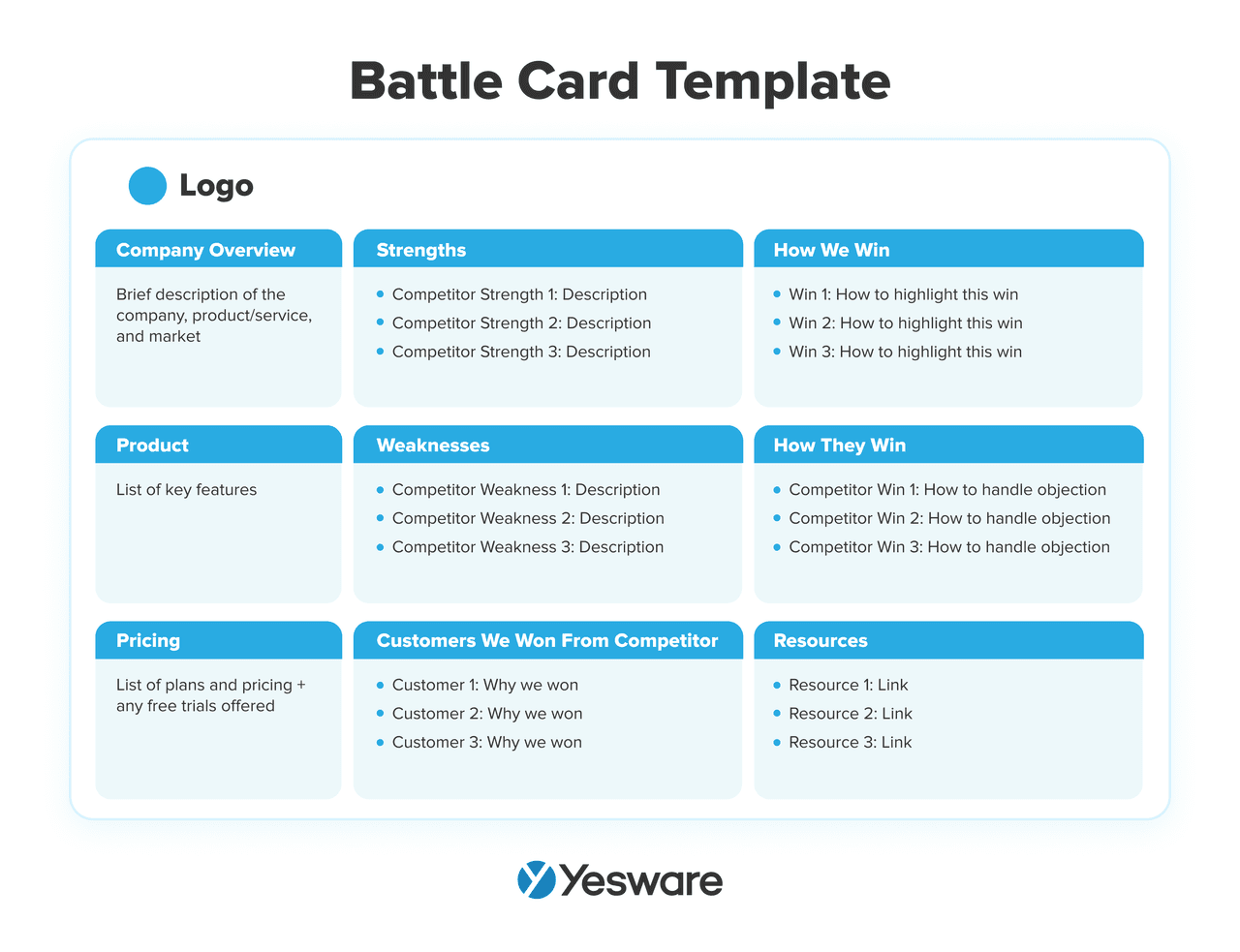 These help salespeople prepare for sales meetings and demos, during which they’ll likely need to speak to the ways in which your company is a better option than your competitor.
These help salespeople prepare for sales meetings and demos, during which they’ll likely need to speak to the ways in which your company is a better option than your competitor.
8. Territory Design Template
Well-designed sales territories see a 10% – 20% increase in sales productivity. Below is a basic example of a territory design map.

9. Market Expansion Plan Template
A market expansion plan outlines the strategies, tactics, metrics, resources, and more that teams will use when expanding into a new market or (more commonly) a new geographical territory.

Market expansion plans also need to include details about distribution expenses and timelines, time zone variations, industry notes or important compliance information, local/cultural expectations and laws, and sometimes more.
10. Compensation Plan Template
Your compensation plan (including a specific commission structure) is one way to motivate your sales reps.
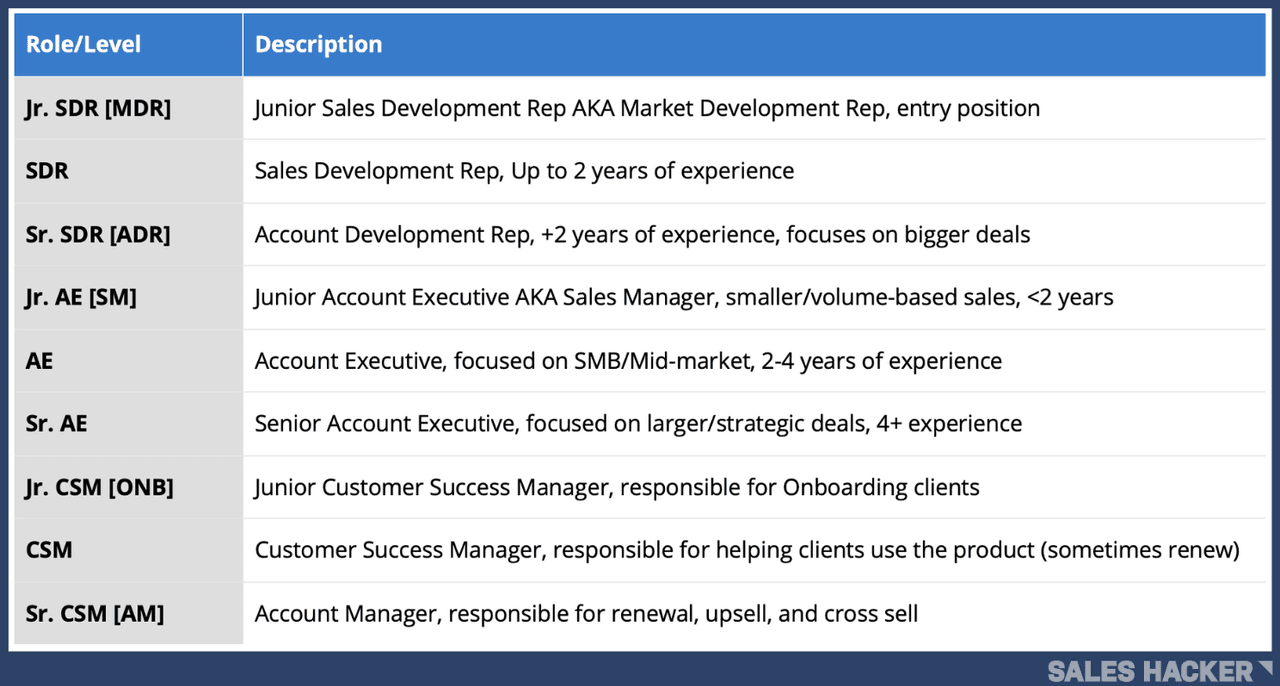
While it may seem controversial or sensitive, the compensation plan is an important component of a strategic sale plan.
11. Sales Funnel Template
The sales funnel is a visual representation of the sales process.
A sales funnel template outlines the way the sales funnel works specifically for your unique sales team. It should also include opportunities for data collection and analysis.  A sales funnel template that your team can update as they move through the sales process can help everyone visualize their individual and collective progress.
A sales funnel template that your team can update as they move through the sales process can help everyone visualize their individual and collective progress.
12. Marketing Plan Template
Your salespeople should be extremely familiar with the marketing strategies your company is using to attract new leads. Here’s a great example of a template you can use in your sales plan that outlines the different campaigns at work.
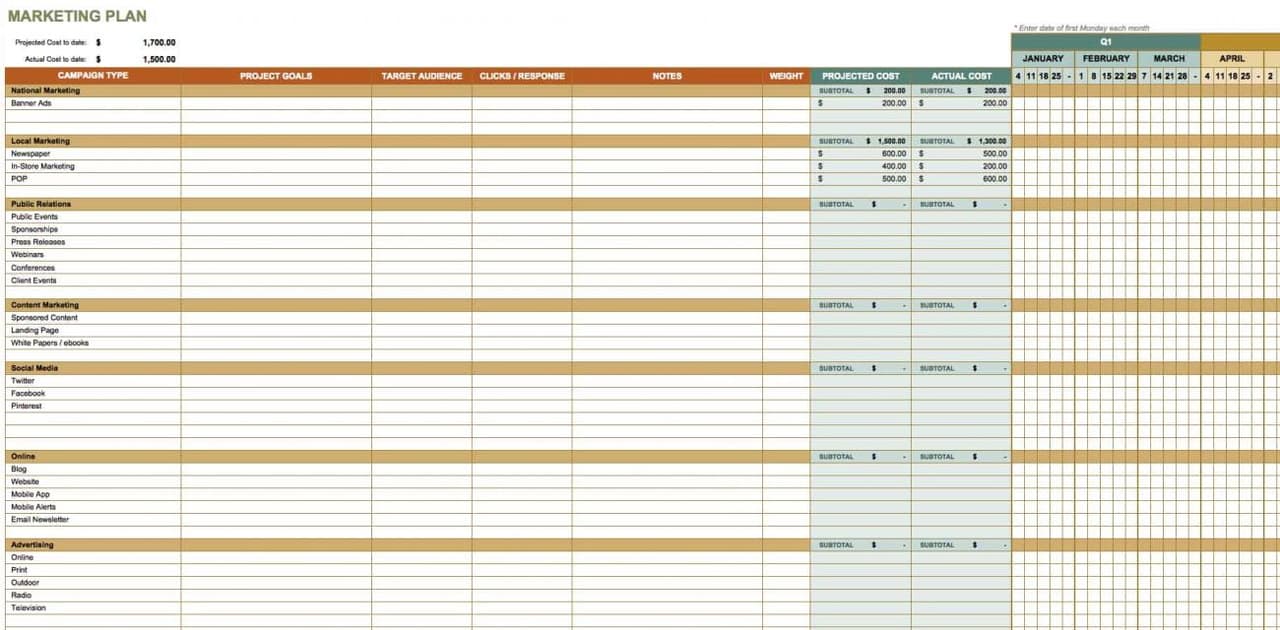
This kind of resource will help your reps know who to contact, when, and with what kind of content throughout the sales cycle.
13. B2B Sales Strategy Template
A B2B sales strategy template helps sales teams outline their goals, as well as the specific methodologies and tactics they will use to achieve them. Here’s an example:

The B2B sales strategy plan will vary widely depending on your team’s specific goals and strategies, but most teams include at least the categories highlighted in the template above.
Put Your Sales Plan Into Action With Yesware
Yesware is the all-in-one sales toolkit that helps you win more business. It can be an invaluable resource for putting your sales plan into action in a way that’s streamlined, productive, and intuitive.
Communication
Yesware’s meeting scheduler tool helps you skip the back-and-forth when scheduling meetings.
Meeting Scheduler integrates with your Outlook or Gmail calendar and helps your clients automatically schedule meetings with you during times of availability. New events will automatically sync to your calendar.

It can also create meeting types for common calls, like a 30-minute intro call or a 60-minute demo call. These templates can be automatically saved and generated with custom descriptions and agendas so everyone can come prepared.
Prospecting
One of Yesware’s most popular features is its prospecting campaigns.
This feature enables salespeople to create automated, personalized campaigns with multi-channel touches.

The tool tracks communication and engagement throughout the process and helps move prospects through the pipeline with little administrative effort from the sales team.
Optimizing
Yesware’s attachment tracking feature helps you find your winning content by tracking which attachments are most often opened and read by your prospects.
You can use these insights to sharpen your content and increase your engagement.

The reporting and analytics tools are also extremely valuable in optimizing your sales plan. These reports enable salespeople to use data to win more business. The feature generates daily activity, engagement data, and outcomes to show you what is/isn’t working across the board.
Try Yesware for free to see how it can help your team carry out your sales plan today.
This guide was updated on March 6, 2024.
Get sales tips and strategies delivered straight to your inbox.
Yesware will help you generate more sales right from your inbox. Try our Outlook add-on or Gmail Chrome extension for free, forever!
Related Articles
Casey O'Connor
Casey O'Connor
Casey O'Connor
Sales, deal management, and communication tips for your inbox


